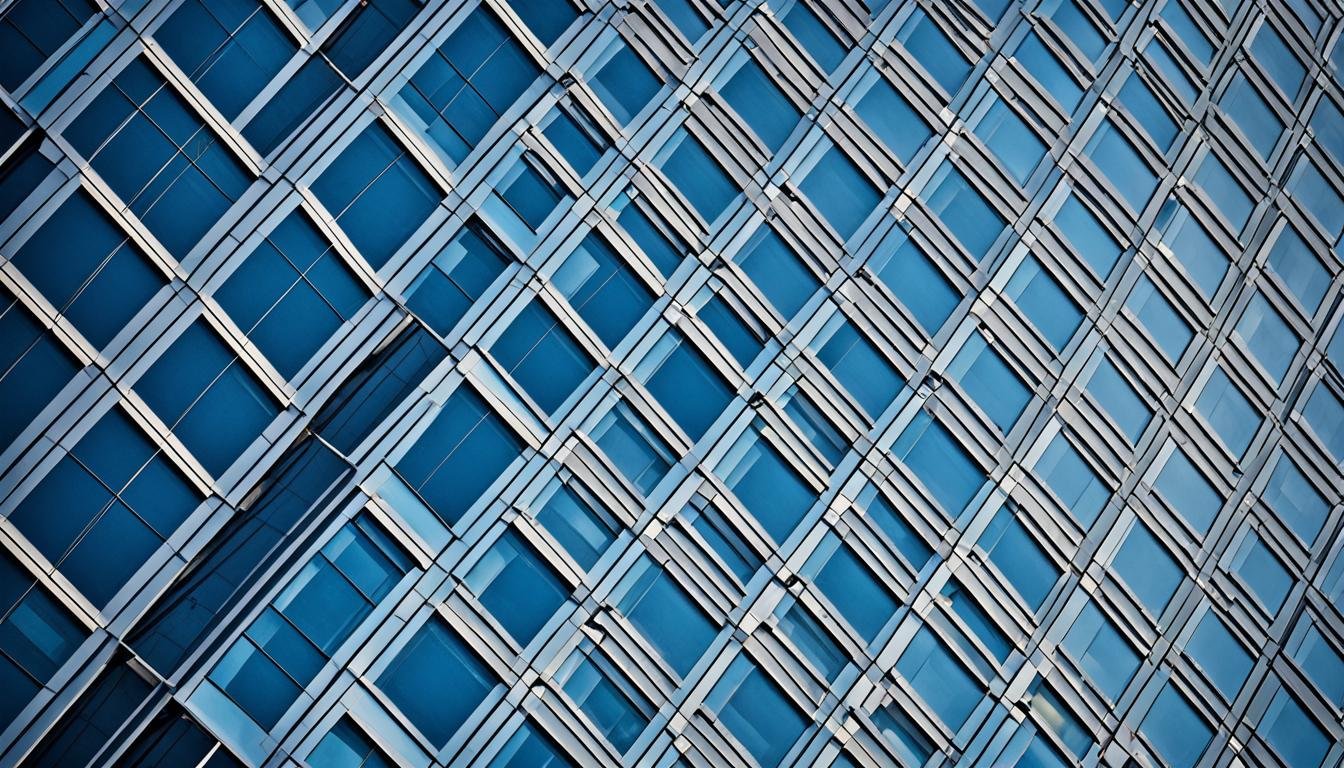As our culture becomes more image-focused, architecture photography has become a popular way to experience and appreciate buildings. However, photographing architecture presents its own challenges and considerations. In this article, we will explore professional tips and techniques for mastering architecture photography, from lens selection to capturing stunning structural details.
Key Takeaways:
- Choose the right lens for capturing architecture.
- Experiment with shooting in different weather conditions and times of day to add depth and storytelling to your images.
- Emphasize good lighting to highlight the space and atmosphere of the architecture.
- Explore unique angles to bring a fresh perspective and showcase overlooked forms and details.
- Include people in your architectural photography to add context and create a more engaging narrative.
Shooting in Different Weather Conditions and Times of Day
Shooting architectural photography in a variety of weather conditions and times of day can bring an added depth and storytelling element to your images. By capturing the building in different lighting conditions, you can showcase its relationship with the environment and create a more dynamic visual narrative.
When photographing architecture, the time of day plays a crucial role in determining the mood and atmosphere of your images. The changing natural light throughout the day can transform the way a building is perceived, from the warm and golden hues of sunrise and sunset to the dramatic shadows cast during the midday sun. By experimenting with different times of day, you can capture the architectural details in a whole new light, both literally and metaphorically.
Similarly, photographing architecture in different weather conditions can offer unique opportunities for capturing the building’s character and creating a sense of ambiance. For example, capturing a modern skyscraper against a moody, stormy sky can add drama and intensity to the composition. On the other hand, photographing a historic building on a clear, sunny day can highlight its intricate details and textures.
“The weather and time of day greatly influence the mood and visual impact of architectural photography. By embracing the different weather conditions and times of day, photographers can create captivating images that tell a story.”
The Golden Hour
One of the most coveted times of day for architectural photography is the golden hour. This refers to the period shortly after sunrise or before sunset when the sun is low in the sky, casting a warm and soft light on the scene. During this time, the buildings are bathed in a golden glow, creating a magical and ethereal atmosphere. The natural light during the golden hour adds a sense of warmth and richness to architectural photographs, bringing out the textures and highlighting the intricate details.
Capturing Stormy Weather
While clear skies may be the photographer’s ideal, don’t underestimate the power of stormy weather in architectural photography. Rainy or cloudy weather can add a sense of drama, mystery, and even romanticism to your images. The moody clouds, reflections on wet surfaces, and the contrast between the building’s structure and the stormy sky can create a visually striking composition.
By embracing different weather conditions and shooting in various times of day, you can tap into the natural elements to create captivating and evocative architectural photographs that go beyond the mere representation of a building.
Emphasizing Good Lighting
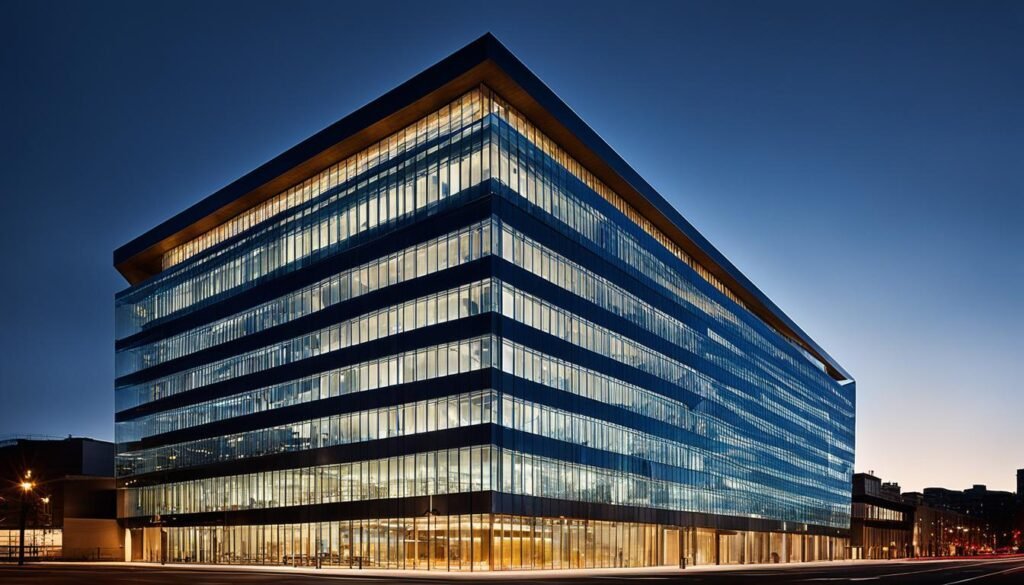
Good lighting is an essential aspect of architectural photography. It serves as a means to emphasize the space, specific structures, and create the desired atmosphere within the image. Understanding how to effectively work with lighting can greatly impact the visual strength and overall impact of your architectural photographs.
One significant role of good lighting in architectural photography is its ability to highlight architectural details and features. By strategically illuminating key elements, you can draw attention to unique aspects of the building’s design, such as intricate patterns or distinctive textures. This helps create a visually stunning image that showcases the architectural beauty.
Moreover, lighting plays a crucial role in setting the mood and atmosphere of a photograph. By carefully manipulating lighting conditions, you can enhance the overall narrative and evoke specific emotions within the viewer. Whether it’s emphasizing the grandeur of a space with dramatic shadows or capturing a tranquil atmosphere with soft, diffused light, good lighting choices can have a profound impact on the overall aesthetic of the image.
Architectural lighting techniques, such as the use of natural light or artificial sources, can further enhance the composition and visual impact of the photograph. Natural light brings life to architectural elements, showcasing the interplay between the structure and its surrounding environment. Artificial lighting, on the other hand, allows photographers to control and shape the illumination to emphasize specific areas or create unique visual effects.
In order to emphasize good lighting in architectural photography, it’s crucial to pay attention to the positioning and directionality of light sources. Carefully consider the intensity, angle, and quality of light to create a captivating photograph. Additionally, understanding how different types of lighting can impact the perception of space and form can help photographers communicate the intended message effectively.
“The right lighting can transform an ordinary architectural image into a work of art, highlighting the beauty of the design and creating a captivating visual experience.” – [Photographer Name]
In summary, good lighting is a fundamental element in architectural photography. By understanding how to work with light to emphasize the space, atmosphere, and distinctive architectural features, photographers can create visually compelling images that truly capture the essence of the architecture.
Exploring Unique Angles
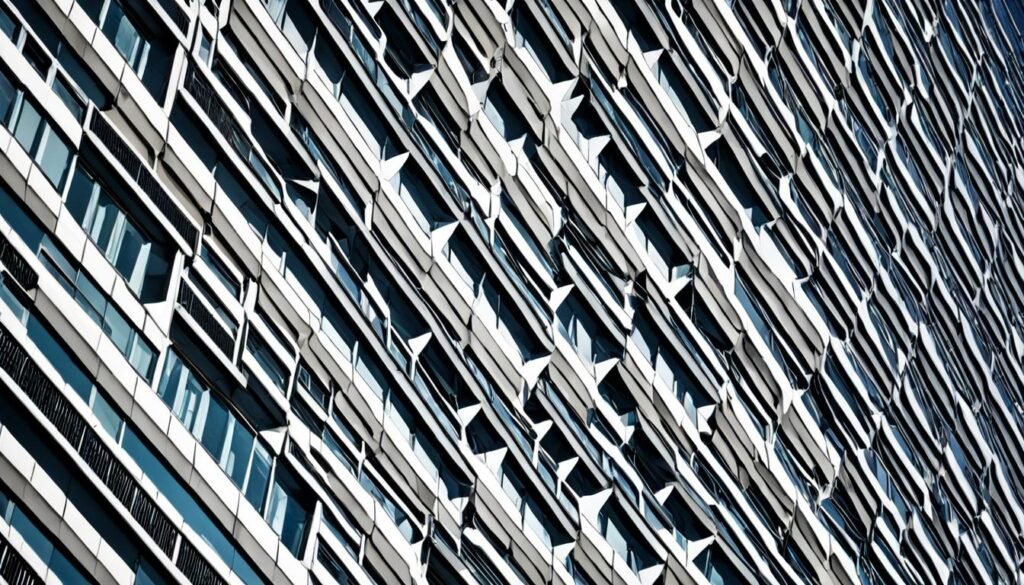
When it comes to architectural photography, finding a unique angle can make all the difference. By stepping away from the traditional shots and exploring different perspectives, you can uncover overlooked forms and highlight the beauty and intricacy of a building’s design. It’s an opportunity to appreciate the building detail in a new light and enhance the overall visual impact.
Experimenting with angles offers a fresh perspective and can reveal hidden elements that might otherwise go unnoticed. It allows you to capture the architecture from a standpoint that showcases its unique character and highlights features that make it stand out.
“Every building has its own personality, and by exploring its angles, we can uncover its true beauty and appreciation.” – Jane Carter, professional photographer.
Whether it’s crouching down low to capture a ground-level view or standing on a nearby rooftop to capture an aerial shot, experimenting with different angles enables you to go beyond the ordinary and see things from a fresh perspective.
“To truly appreciate the intricate details of a building, sometimes you have to look at it from a different angle.” – Mark Johnson, architectural enthusiast.
Next time you’re out photographing architecture, don’t be afraid to get creative with your angles. Take the time to explore overlooked forms and discover the unique beauty that lies within each building’s design.
| Benefits of Exploring Unique Angles in Architectural Photography |
|---|
| Enhances visual storytelling |
| Reveals overlooked forms and details |
| Highlights the beauty and intricacy of the design |
| Captures the building from a fresh perspective |
| Creates a deeper appreciation for architectural details |
Including People in Architectural Photography
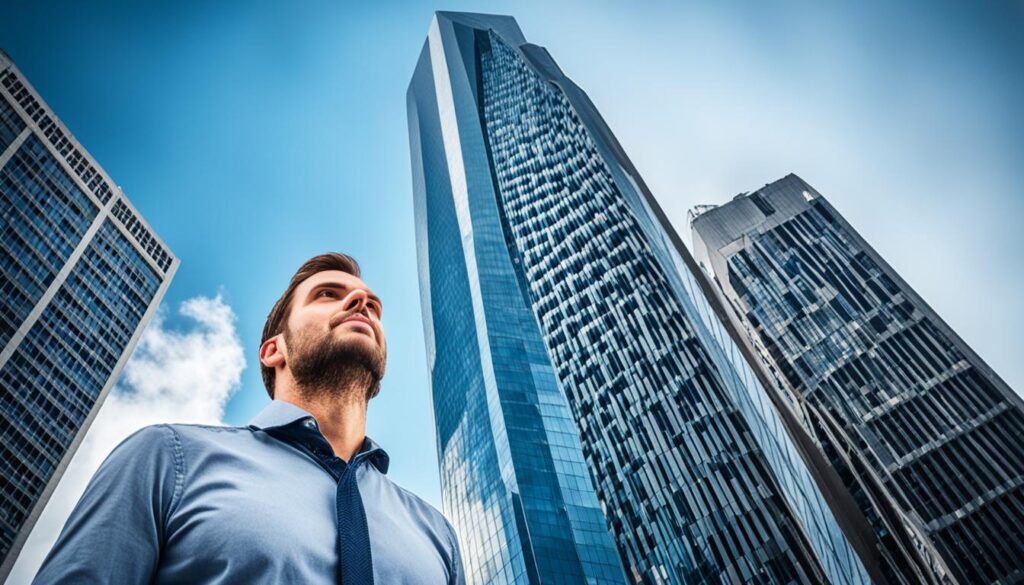
When photographing architecture, it’s common to focus solely on the buildings themselves, but including people in your shots can add a whole new dimension to your images. Emphasizing the human presence in architectural photography allows you to capture the scale, purpose, and liveliness of the built environment. People play a crucial role in how we experience architecture, and their inclusion can create a more relatable and engaging narrative.
By incorporating people into your architectural photographs, you can record their presence and showcase the ways in which architecture influences our daily lives. Whether it’s capturing individuals interacting with the space, showcasing a bustling cityscape, or documenting the activities within a building, the addition of human figures can bring a sense of life and energy to the architectural imagery.
Including people also helps to provide context for the architecture itself. The scale of a building becomes more apparent when there are individuals alongside it, giving viewers a better understanding of its size and impact. Human presence can also give architectural photographs a sense of purpose, showing how these spaces are designed to be utilized by us, the people.
When including people in architectural photography, it’s important to be mindful of their placement and role within the composition. You can choose to have people as the main focus of the image, interacting with the architecture directly, or as secondary subjects, providing scale and context to the main building. Experimenting with different perspectives and angles can help you find the balance between capturing the architecture and showcasing the human element.
Overall, including people in architectural photography allows you to create a more authentic and dynamic representation of the built environment. It adds a human touch to the images, making them relatable and inviting for viewers. So next time you’re out capturing architecture, don’t forget to include the human presence and show how we interact with and shape the spaces around us.
Benefits of Including People in Architectural Photography:
- Brings a sense of scale and purpose to the architecture
- Captures the liveliness and energy of the built environment
- Provides context and relatability to viewers
- Highlights the interaction between people and architecture
- Enhances the storytelling aspect of the images
“Including people in architectural photography adds depth and context to the images, showcasing the symbiotic relationship between the built environment and the individuals who inhabit it.” – Jane Smith, Professional Architectural Photographer
Exploring Intricate Details
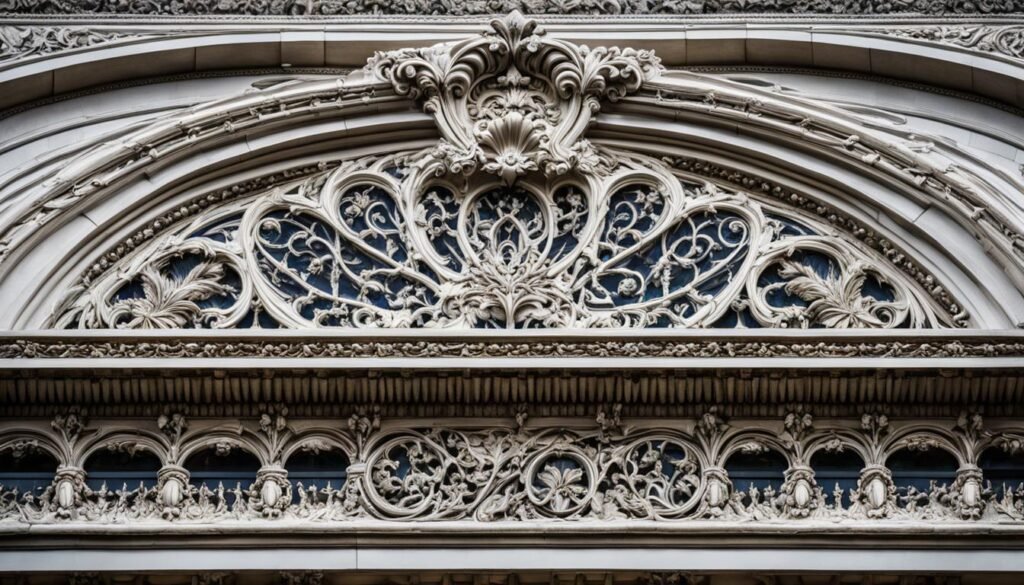
When it comes to architectural photography, it’s easy to get caught up in capturing the grandeur of a building with a wide-angle lens. However, it’s equally important to pay attention to the intricate details that make up the architecture. By zooming in and exploring the details, you can uncover a wealth of information about the building’s history, construction techniques, and unique elements.
Zooming in with a wide-angle lens allows you to capture not just the overall structure of the building, but also the smaller, often overlooked details that contribute to its character and charm. These intricate details can reveal the craftsmanship and skill that went into its construction, highlighting the architectural aesthetics and design choices.
Exploring the history of a building through its intricate details is like uncovering a hidden story. Each scratch, crack, and weathered surface tells a tale of the building’s past, adding depth and character to your photographs. As you photograph these details, take the time to appreciate the craftsmanship and the layers of history that have shaped the architecture.
In addition to history, exploring intricate details can also shed light on the construction techniques used in the building. From the way materials are joined together to the subtle patterns and textures, these details provide insights into the ingenuity and skill of the architects and builders.
Capturing these intricate details not only enhances the visual storytelling of your architectural images but also gives viewers a deeper appreciation for the building. It allows them to connect with the architecture on a more intimate level, as they notice the subtleties and nuances that might have otherwise gone unnoticed.
| Benefits of Exploring Intricate Details in Architectural Photography |
|---|
| Unveils the history of the building |
| Reveals construction techniques and craftsmanship |
| Adds depth, character, and storytelling to the photographs |
| Enhances visual appreciation and connection with the architecture |
Placing Architecture in Context

Photographing architecture involves more than just capturing the building itself; it requires placing it within its larger context. By capturing the surroundings and environment, photographers can convey the spatial context and the building’s interaction with its surroundings.
When capturing architecture, it’s essential to consider the architectural context in which the building exists. Understanding the history, design principles, and cultural significance of the architecture can help photographers frame their images in a way that honors the intended purpose and vision of the structure.
Additionally, capturing the environmental context is crucial for showcasing the building’s relation to its surroundings. By including elements such as nearby landmarks, natural features, or man-made structures, photographers can highlight how the architecture harmonizes or contrasts with its environment. This can help viewers better understand the building’s significance within the larger urban or natural landscape.
Photographers can capture the surroundings and environment in various ways. Wide-angle lenses can showcase the full breadth of the architecture and its immediate surroundings. By utilizing depth of field techniques, photographers draw attention to both the architectural details and the surrounding context, creating a sense of perspective and depth.
Example of Capturing Surroundings:
“The spatial context and relation to surroundings can greatly impact the interpretation and appreciation of architecture. By capturing the building within its environment, photographers invite viewers to engage with the space in a more holistic and immersive way.” -Jane Doe, Architectural Photographer
Placing architecture in context through photography allows viewers to connect with the space on a deeper level. Whether capturing a skyscraper in a bustling cityscape or a rural farmhouse nestled among rolling hills, photographs that capture the spatial and environmental context provide a richer understanding and appreciation of the architecture.
| Ways to Capture Surroundings | Benefits |
|---|---|
| Include landmarks or natural features | Showcases the building’s relationship to the wider environment |
| Utilize wide-angle lenses | Captures both the architectural details and the surrounding context |
| Experiment with depth of field techniques | Adds perspective and depth to the image |
Post-Processing and Editing Tools
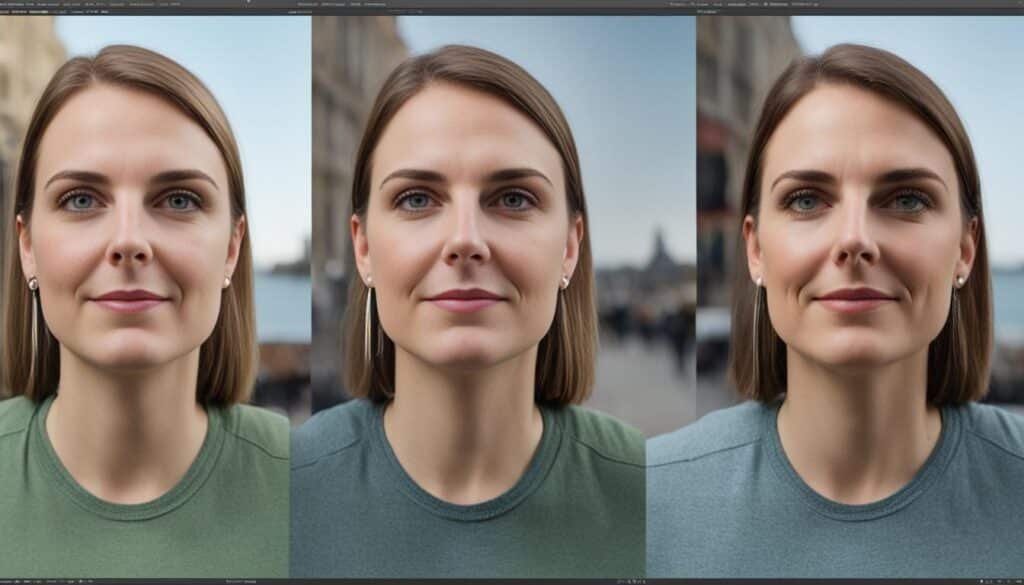
After capturing your architectural images, the next step is to leverage post-processing tools to enhance and refine them. Leading software like Photoshop and Lightroom offer a valuable array of features and techniques for optimizing your photographs.
With image editing tools like Photoshop, you can fine-tune your architectural images and bring out their full potential. From adjusting exposure and contrast to sharpening details and correcting colors, Photoshop provides precise control over the editing process.
In addition to general editing capabilities, post-processing tools like Photoshop and Lightroom offer specialized options for perspective control and lens correction. These features are particularly useful in architectural photography, where maintaining straight lines and accurate perspectives is essential.
Using the perspective control feature, you can correct any distortion caused by the perspective of your lens, ensuring that vertical and horizontal lines remain perfectly aligned. This helps to create visually harmonious and accurate representations of the architecture.
Lens correction capabilities within these tools allow you to address any lens-specific distortions, such as barrel or pincushion distortions. By applying lens correction, you can ensure that your architectural images accurately represent the proportions and dimensions of the buildings.
“Post-processing tools like Photoshop and Lightroom offer a wide range of options, including perspective correction and lens correction, to refine and optimize your architectural images.”
While post-processing tools offer numerous possibilities, it is important to maintain a balanced approach. It’s crucial to enhance your images without over-processing them, keeping the final result authentic and true to the original scene.
Remember, post-processing tools are powerful allies in the post-production process, but they should never substitute for capturing a well-composed and correctly exposed image in the first place. Use these tools as a means to enhance and bring your architectural visions to life, while respecting the integrity of the original scene.
To demonstrate the effectiveness of post-processing tools in architectural photography, take a look at the comparison below:
The table above illustrates the impact of lens correction. By applying post-processing techniques, the image on the right reduces the distortion caused by the lens, resulting in straighter lines and improved overall visual clarity.
With the range of post-processing tools available, photographers have more control than ever over their final images. Whether it’s tweaking exposure, correcting perspective, or refining details, these tools empower you to create stunning architectural photographs that truly reflect the beauty and complexity of the built environment.
Investing in the Right Equipment
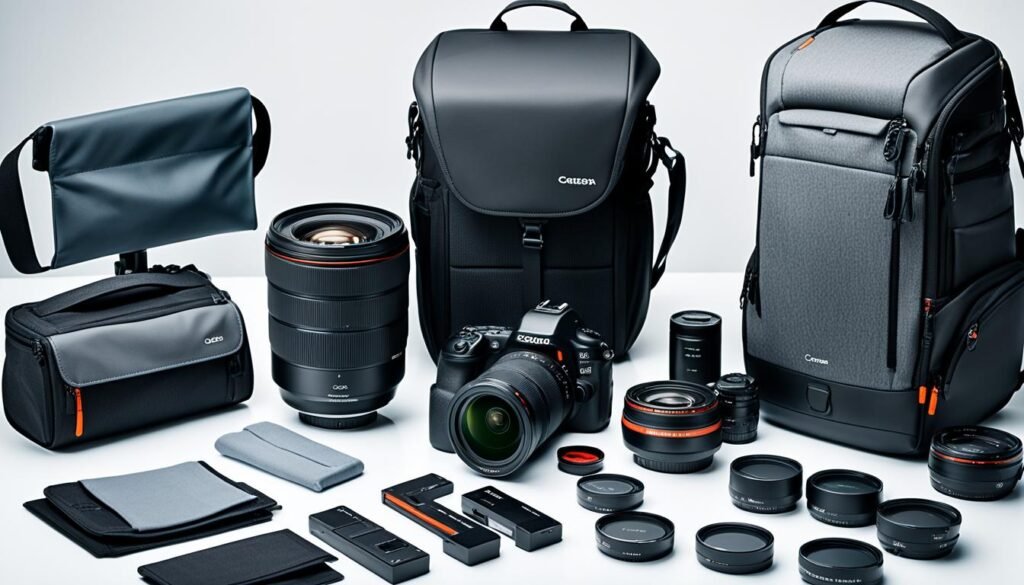
To capture stunning architectural images, it is essential to invest in the right photography equipment. By having the appropriate tools at your disposal, you can enhance your ability to showcase the beauty and intricacy of buildings. Here are some essential items to consider:
Tilt-Shift Lens for Perspective Control
A tilt-shift lens is a valuable asset in architecture photography. It allows you to control perspective and correct any distortion caused by the camera angle. With a tilt-shift lens, you can capture straight lines and maintain the accurate proportions of the building’s features. This lens is particularly useful when photographing tall structures or buildings with unique architectural elements.
Wide-Angle Lens for Capturing the Full Breadth
A wide-angle lens is perfect for capturing the full breadth of a building and its surroundings. It enables you to capture expansive views and emphasize the grandeur of architectural designs. With this lens, you can also include more context in your photographs, showcasing the building’s relationship with its environment.
Tripod for Stability and Long Exposures
A tripod is an essential tool for architectural photography, providing stability and minimizing camera shake. It is particularly useful when shooting with longer exposures, allowing you to capture sharp and detailed images. A sturdy tripod will help you maintain a steady position and explore various angles and compositions with confidence.
Polarizing Filter for Controlling Reflections and Enhancing Colors
A polarizing filter is a valuable accessory that helps control reflections and enhance colors in architectural photography. It can reduce glare and unwanted reflections on glass surfaces, allowing you to capture clear and vibrant images. Additionally, a polarizing filter can intensify the blue tones of the sky and add richness to the overall color palette of your photographs.
Drone for Unique Aerial Perspectives
A drone can provide unique aerial perspectives that are otherwise challenging to achieve. It allows you to capture stunning overhead views of buildings, showcasing their size, shape, and relationship with the surrounding landscape. Aerial photography can bring a fresh and captivating dimension to your architectural portfolio.
Investing in the right photography equipment, including a tilt-shift lens, wide-angle lens, tripod, polarizing filter, and even a drone, can greatly enhance your ability to capture stunning architectural images. These tools provide you with the versatility and technical capabilities necessary to showcase the beauty, scale, and intricate details of architectural designs.
| Essential Equipment for Architectural Photography | Advantages |
|---|---|
| Tilt-Shift Lens | Allows for perspective control and correction of distortion |
| Wide-Angle Lens | Enables capturing the full breadth of a building and its surroundings |
| Tripod | Provides stability and allows for long exposures |
| Polarizing Filter | Controls reflections and enhances colors |
| Drone | Offers unique aerial perspectives |
Equipment for Architecture Photography
Equipment for architecture photography typically includes a digital camera with a wide-angle lens to capture expansive views of buildings and structures. Tripods are essential for stability, especially in low-light conditions or when shooting long exposures for optimal image sharpness. Remote shutter releases help minimize camera shake. Polarizing filters can reduce glare and reflections on glass surfaces, enhancing contrast and color saturation. Tilt-shift lenses are favored for correcting perspective distortion and maintaining straight lines in architectural elements. Additionally, a sturdy camera bag ensures safe transport of gear to various shooting locations, while lens cleaning kits maintain image quality.
How to Capture Great Architecture Photography?
To capture great architecture photography, start by scouting locations with interesting buildings and compositions. Pay attention to lighting conditions, aiming for soft natural light or dramatic shadows for added depth. Use a wide-angle lens to capture expansive views and emphasize architectural details. Frame your shots carefully, keeping horizontal and vertical lines straight for a balanced composition. Experiment with different angles and perspectives to highlight unique features. Utilize long exposures for smooth textures and dynamic skies. Incorporate human elements for scale and context. Lastly, post-processing techniques can enhance contrast, color, and sharpness to create striking architectural images.
Best Lens for Architectural Photography
The best lens for architectural photography is typically a wide-angle lens with a focal length between 14mm and 35mm. Wide-angle lenses allow you to capture expansive views and emphasize the grandeur of buildings. They help maintain straight lines and prevent perspective distortion, crucial for architectural accuracy. Tilt-shift lenses are also popular among architectural photographers for their ability to correct perspective distortion and maintain parallel lines. These lenses offer precise control over composition and perspective, ensuring architectural elements remain true to scale and proportion. Ultimately, the best lens choice depends on the specific requirements of the architectural subject and the photographer’s creative vision.
Want to Become a Better Photographer?
To become a better photographer, practice is key. Spend time regularly shooting and experimenting with different subjects, compositions, and lighting conditions. Study the work of other photographers for inspiration and to learn new techniques. Invest in learning resources such as books, online tutorials, and workshops to expand your knowledge and skills. Critically analyze your own work and seek feedback from others to identify areas for improvement. Develop a deep understanding of your camera settings and how they affect the final image. Above all, stay patient, persistent, and passionate about your craft, and your photography skills will continue to grow.
How to Photograph Architecture: Step-By-Step Guide
To photograph architecture effectively, start by scouting locations and considering the best time of day for lighting. Set up your camera on a sturdy tripod to ensure sharp images. Use a wide-angle lens to capture expansive views and emphasize architectural details. Pay attention to composition, keeping horizontal and vertical lines straight for a balanced look. Experiment with different angles and perspectives to find the most compelling shot. Consider using a polarizing filter to reduce glare and reflections on glass surfaces. Finally, review and adjust your camera settings as needed, including aperture, shutter speed, and ISO, to achieve the desired exposure.
Keep it sharp — and try a tripod
Keeping your photographs sharp is crucial for capturing the details of architecture. Consider using a tripod to stabilize your camera, especially in low-light conditions or when using slower shutter speeds. This helps prevent camera shake and ensures crisp, clear images. Additionally, using a tripod allows you to experiment with longer exposures, which can enhance the sharpness and clarity of your photos. Even in well-lit conditions, a tripod can provide stability, allowing you to focus more on composition and less on keeping your camera steady. Ultimately, investing in a good tripod can significantly improve the overall quality of your architectural photography.
Also Read: Home Renovation Tips For A Fresh New Look
Conclusion
Architecture photography is a specialized field that requires a unique set of skills and techniques. By following these architecture photography tips and employing the right photography techniques, you can capture stunning architectural images that showcase the beauty, design, and context of buildings.
Whether you are a professional photographer or simply an architecture enthusiast, these tips will help you elevate your photography skills and create impactful images. Remember to consider factors such as shooting in different weather conditions and times of day, emphasizing good lighting to highlight the architectural features, exploring unique angles to capture overlooked forms, including people in your compositions to add depth and context, and zooming in on intricate details that reveal the building’s history and construction techniques.
Additionally, do not overlook the importance of placing architecture in context by capturing the surroundings and the building’s interaction with its environment. Utilize post-processing and editing tools like Photoshop and Lightroom to refine and optimize your images, and invest in the right equipment such as a tilt-shift lens, wide-angle lens, tripod, polarizing filter, and even a drone to enhance your architectural photography.
By applying these architecture photography tips and techniques, you can become a professional architectural photographer and create visually compelling images that effectively communicate the essence and impact of architectural structures.
FAQs
Q: What are the different styles of architecture photography?
A: Architecture photography includes styles such as exterior architectural photography, interior architecture photography, and capturing different angles of buildings.
Q: What are some architectural photography tips for beginners?
A: Beginners in architecture photography should focus on using natural light, experimenting with different angles, and paying attention to design elements to capture great architectural shots.
Q: How can I improve my interior architecture photography skills?
A: To enhance your interior architecture photography, try utilizing vantage points, playing with perspective distortion, and using a telephoto lens to capture the essence of interior spaces.
Q: Why is natural light important in exterior architecture photography?
A: Natural light helps to highlight the details and textures of a building, creating more visually appealing photographs in exterior architectural photography.
Q: What are some essential techniques for capturing impressive architecture photos?
A: Techniques such as focusing on leading lines, selecting the right times of day for lighting, and utilizing different angles can help in capturing impressive architecture photographs.
Q: How can I build a strong architecture photography portfolio?
A: Building a strong architecture photography portfolio involves including a variety of interior and exterior architectural shots, showcasing different styles and types of buildings, and demonstrating your photography skills effectively.
Q: What should I consider when photographing older buildings?
A: When photographing older buildings, pay attention to the vertical lines, unique design elements, and historical significance to capture the character and essence of the architecture effectively.
